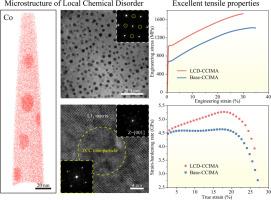化学复杂金属间合金的局部化学紊乱及其异常影响
IF 14.3
1区 材料科学
Q1 MATERIALS SCIENCE, MULTIDISCIPLINARY
引用次数: 0
摘要
新出现的化学复杂金属间合金有望在金属材料领域取得突破性进展。然而,许多现有的ccima由于其单相结构,仍然存在屈服强度有限的问题,严重限制了其广泛应用。在这里,我们成功地解决了这一关键问题,通过可控地将具有面中心立方(FCC)结构的局部化学无序(LCD)引入l12型ni - co - si - ti - al基CCIMA中,获得了优越的屈服强度~ 1033 MPa和极限抗拉强度~ 1730 MPa,以及优异的抗拉伸长率~ 29%。独特的LCD产生异常强化效应,估计为~ 345 MPa。同时,这些具有较低层错能的无序纳米颗粒也促进了CCIMA中超晶格本禀层错(SISF)网络的成核,从而导致了塑性变形后期的高应变硬化率。这项工作为开发用于先进结构应用的强韧CCIMA提供了新的见解。本文章由计算机程序翻译,如有差异,请以英文原文为准。

Local chemical disorder and its anomalous impacts in chemically complex intermetallic alloys
The newly emerged chemically complex intermetallic alloys (CCIMAs) are expected to achieve breakthrough advancements in metallic materials. However, many existing CCIMAs still suffer from limited yield strength due to the single-phase structure, seriously limiting their widespread applications. Here, we successfully resolve this critical issue by controllably introducing the local chemical disorder (LCD) with face-centered-cubic (FCC) structure into the L12-type Ni-Co-Si-Ti-Al-based CCIMA, achieving a superior yield strength of ∼1033 MPa and ultimate tensile strength of ∼1730 MPa, and outstanding tensile elongation of ∼29%. The unique LCD produces an anomalous strengthening effect, which is estimated to be ∼345 MPa. Meanwhile, these disordered nanoparticles with lower stacking fault energy also promote the nucleation of superlattice intrinsic stacking fault (SISF) networks in the CCIMA, contributing to a high strain-hardening rate in the late stage of plastic deformation. This work provides a new insight into developing a strong yet ductile CCIMA for advanced structural applications.
求助全文
通过发布文献求助,成功后即可免费获取论文全文。
去求助
来源期刊

Journal of Materials Science & Technology
工程技术-材料科学:综合
CiteScore
20.00
自引率
11.00%
发文量
995
审稿时长
13 days
期刊介绍:
Journal of Materials Science & Technology strives to promote global collaboration in the field of materials science and technology. It primarily publishes original research papers, invited review articles, letters, research notes, and summaries of scientific achievements. The journal covers a wide range of materials science and technology topics, including metallic materials, inorganic nonmetallic materials, and composite materials.
 求助内容:
求助内容: 应助结果提醒方式:
应助结果提醒方式:


